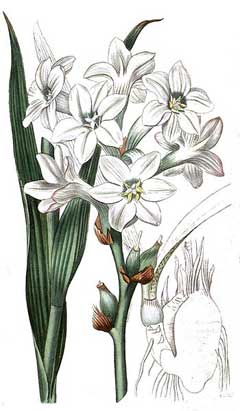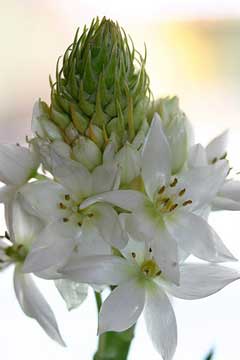 |
|
http://commons.wikimedia.org/wiki/File:Polianthes_tuberosa_clean.jpg |
 |
| ttp://picasaweb.google.com/lh/photo/hj_lexQkXbgoFPhEslGkKw |
Translate this page:
Summary
Physical Characteristics

 Polianthes tuberosa is a BULB growing to 1 m (3ft 3in) by 0.2 m (0ft 8in).
Polianthes tuberosa is a BULB growing to 1 m (3ft 3in) by 0.2 m (0ft 8in).
See above for USDA hardiness. It is hardy to UK zone 9 and is frost tender. The species is hermaphrodite (has both male and female organs).
Suitable for: light (sandy) and medium (loamy) soils and prefers well-drained soil. Suitable pH: mildly acid, neutral and basic (mildly alkaline) soils. It cannot grow in the shade. It prefers moist soil.
UK Hardiness Map
US Hardiness Map
Synonyms
Plant Habitats
East Wall. By. South Wall. By. West Wall. By.
Edible Uses
Edible Parts: Flowers
Edible Uses:
Flowers - cooked. Used in vegetable soups or added to the substrate of 'kecap', an Indonesian soy sauce[46, 177, 183]. The flowers are the source of tuberosa-flower water[183]. No further details are given.
References More on Edible Uses
Medicinal Uses
Plants For A Future can not take any responsibility for any adverse effects from the use of plants. Always seek advice from a professional before using a plant medicinally.
None known
References More on Medicinal Uses
The Bookshop: Edible Plant Books
Our Latest books on Perennial Plants For Food Forests and Permaculture Gardens in paperback or digital formats.

Edible Tropical Plants
Food Forest Plants for Hotter Conditions: 250+ Plants For Tropical Food Forests & Permaculture Gardens.
More

Edible Temperate Plants
Plants for Your Food Forest: 500 Plants for Temperate Food Forests & Permaculture Gardens.
More

More Books
PFAF have eight books available in paperback and digital formats. Browse the shop for more information.
Shop Now
Other Uses
Essential
An essential oil is obtained from the flowers. It is used in high grade perfumery[46, 61, 171]. 1150kg of flowers yield 1kg absolute essential oil[46, 61].
Special Uses
Scented Plants
References More on Other Uses
Cultivation details
Requires a warm sheltered position[200] and a well-drained soil[188]. When grown in pots it is best to use a fibrous loam enriched with compost and some silver sand for drainage[245]. Plants require copious amounts of moisture when starting into growth[245]. Not very hardy outdoors in Britain, this species is often grown in the greenhouse where it can be induced to flower at almost any time of the year[1]. It can also be grown outdoors in warm areas of Britain, planting out the bulbs in spring, harvesting them in the autumn and storing them in sand overwinter in a cool but frost-free place[200]. This species is sometimes cultivated for its edible flowers[183]. They are very strongly scented[200]. The flowers are perhaps the most powerfully scented of all flowers. The perfume is almost intoxicating, especially when the plant is grown in gentle heat when it is heavy and sickly almost to the point of unpleasantness[245]. A double-flowered cultivar, 'The Pearl' has an even more pronounced fragrance[245]. The plant is cultivated for its essential oil in China[61].
References Carbon Farming Information and Carbon Sequestration Information
Temperature Converter
Type a value in the Celsius field to convert the value to Fahrenheit:
Fahrenheit:
The PFAF Bookshop
Plants For A Future have a number of books available in paperback and digital form. Book titles include Edible Plants, Edible Perennials, Edible Trees,Edible Shrubs, Woodland Gardening, and Temperate Food Forest Plants. Our new book is Food Forest Plants For Hotter Conditions (Tropical and Sub-Tropical).
Shop Now
Plant Propagation
Seed - we have no information on this species but suggest sowing the seed in spring in a sunny position in a greenhouse. When they are large enough to handle, prick the seedlings out into individual pots and grow them on in the greenhouse for at least their first winter. Plant them out into their permanent positions in late spring or early summer, after the last expected frosts. Division of offsets after the plant has finished flowering in late summer.
Other Names
If available other names are mentioned here
Native Range
NORTHERN AMERICA: Mexico (Campeche, Chiapas, Guerrero, México, Michoacán de Ocampo, Morelos, Oaxaca, Quintana Roo, Veracruz de Ignacio de la Llave, Yucatán)
Weed Potential
Right plant wrong place. We are currently updating this section.
Please note that a plant may be invasive in one area but may not in your area so it's worth checking.
Conservation Status
IUCN Red List of Threatened Plants Status :

Growth: S = slow M = medium F = fast. Soil: L = light (sandy) M = medium H = heavy (clay). pH: A = acid N = neutral B = basic (alkaline). Shade: F = full shade S = semi-shade N = no shade. Moisture: D = dry M = Moist We = wet Wa = water.
Now available:
Food Forest Plants for Mediterranean Conditions
350+ Perennial Plants For Mediterranean and Drier Food Forests and Permaculture Gardens.
[Paperback and eBook]
This is the third in Plants For A Future's series of plant guides for food forests tailored to
specific climate zones. Following volumes on temperate and tropical ecosystems, this book focuses
on species suited to Mediterranean conditions—regions with hot, dry summers and cool, wet winters,
often facing the added challenge of climate change.
Read More
Expert comment
Author
L.
Botanical References
200
Links / References
For a list of references used on this page please go here
Readers comment
© 2010, Plants For A Future. Plants For A Future is a charitable company limited by guarantee, registered in England and Wales. Charity No. 1057719, Company No. 3204567.